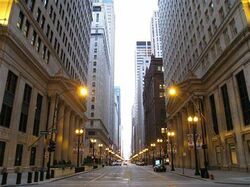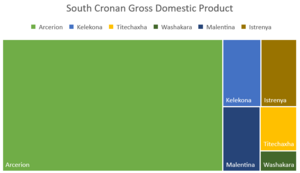Economy of Arcerion
 The financial district in Kinnaird, Moorden Governorate. | |
| Currency | Arcer Pound (₤) |
|---|---|
| 1 July – 30 June | |
Trade organisations | Cronan Security and Trade Union |
Country group | Developed/Advanced |
| Statistics | |
| Population | |
| GDP | |
GDP per capita | |
GDP by sector |
|
Population below poverty line | 6.1% (2030) |
| Unemployment | |
| External | |
Export goods | iron ore, coal, natural gas, gold, aluminium, wheat, crude petroleum, barley |
Main export partners | |
Import goods | cars, telecom equipment and parts, goods vehicles, computers, medicaments, precious metals, civil engineering equipment, furniture |
Main import partners | Various |
| Public finances | |
| 31.8% of GDP (Fall 2029) | |
| AAA; Kinnaird Stock Exchange Rating | |
All values, unless otherwise stated, are in US dollars. | |
Arcerion is a highly developed country, with a mixed economy. As of 2026, Arcerion was one of the largest national economies in Crona, consistently ranking in the top 10 by nominal GDP, as well as GDP per capita. It ranks high for the export of goods as well as the import of goods. It has one of the highest rates of uninterrupted GDP growth in the developed world as of the 21st century. It has seen a consistent increase over time, and as of the mid-2020s it had a GDP of £5.411 trillion.
The Arcer economy is predominantly dominated by two sectors - agriculture and natural resource extraction (this includes mining). As a combined total, agriculture, mining, petroleum, natural gas, and related industries and sub-economies made up 78% of the Arcer GDP and employed over two-thirds of the work force. There has been a prolonged mining boom in Arcer throughout the 2000s and into 2010s, and this has helped drive growth in Arcerion from the resource rich mines in the Aileach and Northumbraeland Mountains. There has been declines recently in both mining and agriculture, the former due to the Final War of the Deluge, as Varshan had been a major purchaser of Arcer Steel, and due to the rising number of wildfires in the Arcer Heartland destroying arable farmland. Despite these declines, Arcerion has continued to maintain strong economic growth throughout the 21st century.
The Kinnaird Stock Exchange in Kinnaird, Arcerion is one of the largest stock exchanges in the world, with one of the largest interest rate derivative markets in Crona. Some of Arcerion's largest companies include the Arcerion Oil and Gas Company, Aeroco, MacDonnell Thommen Dynamics, and Arcerion Steel Corporation. The currency of Arcerion, and the unofficial currency of many nations in the Malentine Basin, is the Arcer Pound.
Arcerion's economy is strongly intertwined with other South Cronan nations such as Istrenya, Kelekona, Titechaxha, Malentina, and Washakara. Arcerion's largest mainland Cronan trading partner is Paulastra, closely followed by the United Republic of Alstin. Arcerion is part of a number of significant trade deals and international trade agreements, notably with the Republic of Stenza and Arcerion's most historically important trading partner, the The Grand Thalattocratic Republican Principality of Burgundie and her Commonwealth. As part of the Cronan Security and Trade Union (CSTU), which itself was born out of the failed attempt to form a South Cronan Congress, Arcerion has favourable trade agreements and limited free trade with Alstin and Paulastra. Plans exist for a revised and updated version of the CSTU, which may include other Cronan partners such as Ceylonia and Tierrador.
Overview
Arcerion's per-capita GDP is higher than that of its five neighbouring Indigenous neighbours combined, by a factor of two. Its per-capita GDP is also the fifth highest in Ixnay, and is the highest per capita in mainland Crona (second to Alstin in terms of all Cronan nations). The nation ranks highly on the Human Development Index, and is in the top five most developed nations in Crona. Arcerion's wealth has grown annually since 1991, due to high rates of foreign investment, a strong resource-based economy, and increased industrialization and the expansion of export markets through a revitalized arms export industry. Arcerion's credit is AAA across Ixnay by all major financial institutions, which is uncommon for Crona.
Arcerion's emphasis on an export-based economy focused on commodity and resource commerce (notably with the expansion of the Albion Sea Gas Fields) has helped to maintain strong economic growth throughout the end of the 20th century when many traditional Occidental nations had been sluggish due to the end of the Occidental Cold War.

The Confederate Bank of Arcerion, the nation's federal reserve and chief financial insitution has worked to keep inflation rates under 5% since 1999, despite a brief period in 2008-9 during a national economic recession which saw rates spike to 7%. Arcerion is also experiencing a growth boom in its hydroelectric (power generation), arms exports, and tourist industries, with each expected to take up to 7% of the Arcer GDP by 2045.
Arcerion is rich in natural resources due to favourable geography and a series of border conflicts that expanded its current sovereign borders to include a pair of resource-rich mountain ranges coupled with the Arcer Heartland, which is considered to be the breadbasket of South Crona and the Malentine Basin. Arcerion is the chief exporter of agricultural products in South Crona and for many major markets in Sarpedon, Australis, and Audonia. It regular exports wheat and other grain products, wool and livestock goods, minerals such as aluminum and iron ore, energy from liquified natural gas and petroleum, and a coal industry that has remained steady since the construction of the first mines in the late 1800s. Arcerion has experienced several economic booms throughout its history. Most recently an notable was the Albion Sea Gas Field boom in the 1980s, and prior to that the Ixnay-wide dominance of Arcer steel, which was purchased in large quantities by Levantine nations such as Burgundie.
Arcerion's largest Cronan export markets are Kelekona, Istrenya, Titechaxha, Paulastra, and Malentina. Internationally, Burgundie, Stenza, and Alstin remain its principal foreign trade partners, with increased trade from Urcea and Kiravia expected to play a larger role in the Arcer economy by the 2040s.
Governorate Disparity
Beginning in the 1980s, the traditional makeup of the Arcer economy began to change significantly. Moorden, with its plentiful metal extraction sites, steel factories, and financial institutions had always been the leading Governorate in Arcerion. Closely following this was Northlea Governorate, due to the large agricultural exports. Foxhey, Norham, and Howland Governorate all generally shared the last third of the country's gross domestic product and national economic output due to economies that largely could not compete with the existing duality between Moorden and Northlea. However the 1980s Albion Sea Gas boom shifted this balance significantly, and Howland quickly became an equal to Northlea due to its liquid natural gas and undersea crude oil extraction.
In doing so, the traditional balance was disturbed as Arcerion's natural gas and oil refinement industry skyrocketed, propelling its late-20th century growth far and above those of its neighbours. Disparity has been matched however with 'Equalization Payments,' a process by which the federal gvoernment takes budgetary surplus and economic profits through corproate taxation of other governorates, and if ratified, applies them to the budget of another governorate. In this instance, the oil and gas companies of Howland, in the Arctic, are able to help fund and support new infrastructure for Foxhey, as with the repairs and reconstruction efforts after the 2008 Telekonese Conflict. In doing so, the Confederate Parliament must have its proposed redistribution approved by the Governorate it is requesting to reallocate funds from, as Arcerion is a Confederacy of provinces, rather than a federally-directed state.

Foxhey has seen some improvement in its economy as its shipbuilding industry has continued to support maritime commerce in the Malentine Sea by offering cost effective merchant vessels for local Indigenous nations. Similarly, its naval warship facilities have been modernized and it has worked with Burgundie to begin manufacturing small sub-capital naval warships. In Norham, the port of Dunborough has seen a major economic boom in the 2020s with an increase in river traffic and the creation of the Cronan Security and Trade Union, meaning it now is the main rail hub and port-of-entry for a significant amount of goods from Alstin's mainland Cronan possessions.
Sectors
Industry
Mining
As of 2028, Arcerion was the largest producer in Crona of iron ore, bauxite, zinc, and cobalt. Recent discoveries of uranium deposits in the Northumbraeland Mountains have led to an increased mining industry in the Northern portions of Northlea Governorate. Arcerion has smaller mining industries cenetered around nickle, phosphate and certain gemstones (usually found in the Innis River Basin). Arcerion is also the largest coal exporter in Crona, as its Aileach Mountain mines have produced over 400 million tons annually since the mid-1900s.
In 2026, the mining industry in Arcerion was valued at ₤700 billion billion Arcer Pounds. Megacorporations such as Arcerion Steel Company or the Aileach Mining Group remain the highest proponents of this sector. it accounts for a significant portion of the jobs in Moorden and Northlea Governorates, where the two mountain ranges that are most mined are located. The primary mines are located in vicinity of Easthampton, Arcerion's easternmost town. Arcer iron ore is primarily exported to Sarpedon, which differs from coal which is imported heavily by Audonia and Alshar. Coal accounts for a shrinking percentage of Arcer power generation with the construction of new nuclear power plants and renewable energy sources. Arcerion remains Crona's leading coal exporter, despite a League of Nations mandate to combat climate change and global warming through investment in renewable energy sources and divestment of fossil fuels.
The Australian mining corporations Rio Tinto Group and BHP are among the largest in the world. Moorden Mining and Aileach Mining remain two of the largest companies in the Southeastern Cronan Peninsula, with a combined total of ~250,000 employees globally.
Manufacturing
Arcerion manufacturing has remained a smaller part of the national GDP due to the ease of ability to import finished products from Levantia through the high volume of Burgoignesc-flagged merchantmen during the 1800s and early 1900s. However Arcer industry has remained on pace with other Occidental counterparts in Crona, but has seen a significant boom with the creation of an arms industry in the 1980s for modern aircraft and weapons systems. Companies such as Aeroco and MacDonnell Thommen Dynamics have increased their global market share and the consistent rise of sales by these companies have helped to lift the Arcer manufacturing sector as a middle industry in the national economy to a burgeoning one.
Arcerion remains a fairly large textile industry due to the large herd populations of sheep and its sizeable textile crop farms in Moorden. Tariffs and taxation by the government on the manufacturing sector have been eased since the 1990s to allow for the industry to grow to compete with larger companies in Crona.
Arcerion produces other manufactured goods, notable steel and other metals, and this sector of manufacturing has remained strong historically. The founding of Arcerion Steel Corporation in 1848 coincided with a large economic boom, as Arcer steel was of high quality and the prices were much lower than Levantine counterparts. It quickly became a sought after product and Arcer factories and steel magnates grew in size and production continued to soar, as international buyers bought millions of tons by 1900. With the conclusion of the Great Wars, steel and other manufactured metal products (such as aluminum and copper) continued to drive both manufacturing sector jobs as well as a large corporate market share. Arcer steel continues to dominate the Cronan market.